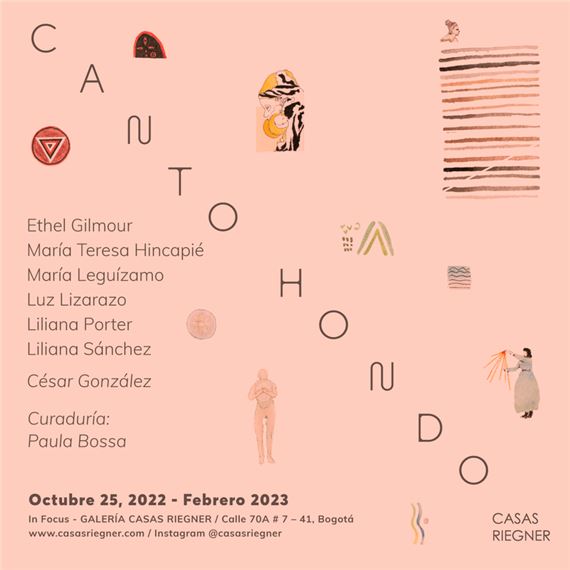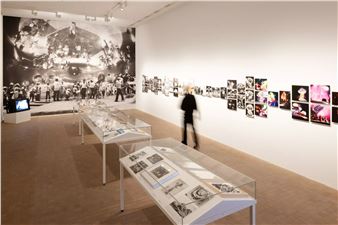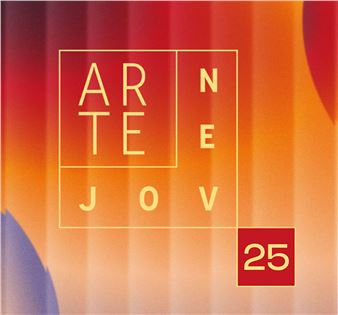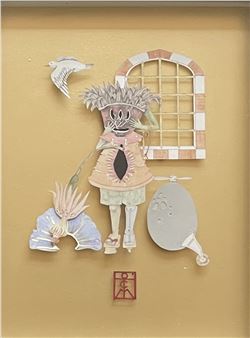Canto hondo
Canto hondo [Deep Song] fixes its gaze on the inner world of the feminine, specifically on the instinctive nature or wild woman[1]—that wise, intuitive, creative, and visceral force residing in the depths of every woman's soul that is often overshadowed by "over-domestication" or "exclusion by one's surrounding culture." It likewise introduces a masculine voice that integrates and embraces the essence of the wild feminine, managing to renew and redefine what we understand by masculinity.
Singing, in the words of writer and psychoanalyst Clarissa Pinkola EstĂ©s, “is a special form of language that makes it possible to achieve things that the spoken voice cannot.” It is also the language of the soul, an expression of truth, of personal power and of one's own needs.[2] A vessel of feminine songs, Canto hondo acknowledges and exalts the deep and enigmatic voices of artists MarĂa Teresa HincapiĂ©, Ethel Gilmour, Liliana Porter, Luz Lizarazo, Liliana Sánchez, and MarĂa Leguizamo who, through their sensitive and evocative pieces, fully reveal their natural essence. Simultaneously, the artistic voice of Cesar González is materialized in intimate drawings, the majority of which are replete with symbols alluding to mythology and the great women of history. These are integrated to uphold and respond to feminine essence, thus revealing aspects of masculinity that transcend the deep-rooted and obsolete patriarchal frameworks that have long been used to understand the role of men in our society.
To speak of a deep voice is to speak of our inner world, that intangible, complex universe in which dwell light and shadow, of that which escapes description in words yet we know embraces the deepest and most intimate part of every human being. Rarely do we allow this world be seen for fear of being judged or because excessive ego or intellectualism forbids or masks it. However, to connect with this universe there must be a longing to do so, as well as willingness to delve into the deepest recesses. We arrive there through activities that require altered consciousness, such as meditation, writing, singing, dance, and artistic creation, among others.

Recommended for you
Canto hondo [Deep Song] fixes its gaze on the inner world of the feminine, specifically on the instinctive nature or wild woman[1]—that wise, intuitive, creative, and visceral force residing in the depths of every woman's soul that is often overshadowed by "over-domestication" or "exclusion by one's surrounding culture." It likewise introduces a masculine voice that integrates and embraces the essence of the wild feminine, managing to renew and redefine what we understand by masculinity.
Singing, in the words of writer and psychoanalyst Clarissa Pinkola EstĂ©s, “is a special form of language that makes it possible to achieve things that the spoken voice cannot.” It is also the language of the soul, an expression of truth, of personal power and of one's own needs.[2] A vessel of feminine songs, Canto hondo acknowledges and exalts the deep and enigmatic voices of artists MarĂa Teresa HincapiĂ©, Ethel Gilmour, Liliana Porter, Luz Lizarazo, Liliana Sánchez, and MarĂa Leguizamo who, through their sensitive and evocative pieces, fully reveal their natural essence. Simultaneously, the artistic voice of Cesar González is materialized in intimate drawings, the majority of which are replete with symbols alluding to mythology and the great women of history. These are integrated to uphold and respond to feminine essence, thus revealing aspects of masculinity that transcend the deep-rooted and obsolete patriarchal frameworks that have long been used to understand the role of men in our society.
To speak of a deep voice is to speak of our inner world, that intangible, complex universe in which dwell light and shadow, of that which escapes description in words yet we know embraces the deepest and most intimate part of every human being. Rarely do we allow this world be seen for fear of being judged or because excessive ego or intellectualism forbids or masks it. However, to connect with this universe there must be a longing to do so, as well as willingness to delve into the deepest recesses. We arrive there through activities that require altered consciousness, such as meditation, writing, singing, dance, and artistic creation, among others.

 ARTISTS
ARTISTS
















